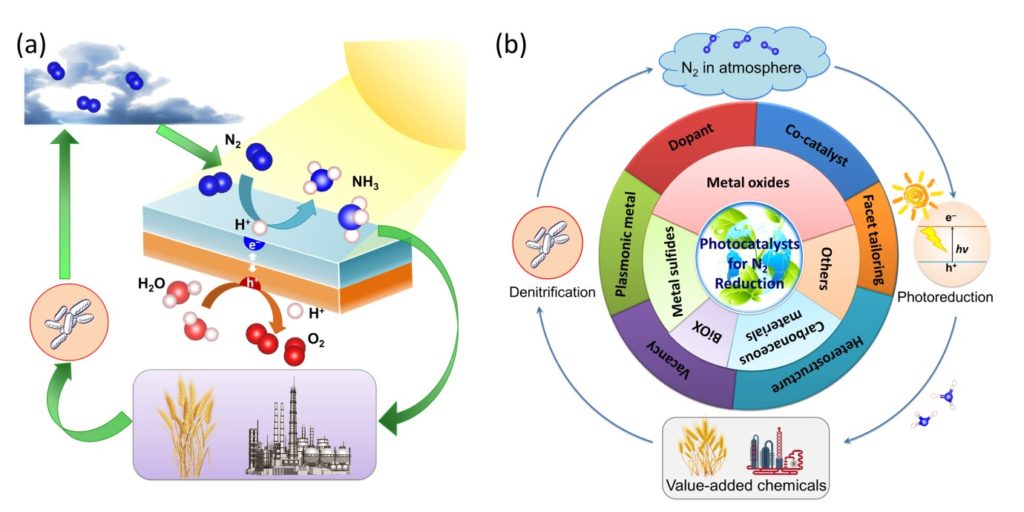Is it feasible to convert nitrogen to ammonia using water and light?
通过国际合作,scientists from China and Singapore have looked into the aspect of the state-of-the-art engineering of photocatalysts for the nitrogen (N2) fixation toward understanding the ammonia (NH3) synthesis.The work was recently reported byDr.Wee-Jun Ong和同事在Materials Horizons,which is featured on the Inside Front Cover in Volume 5,Issue 1 in 2018.
(a) An overview of the N2cycle and circulation of N2形式多样。(b) Diagram of the state-of-the-art milestone in the development of photocatalysts for N2固定。Images adapted from Chen et al.,Mater.Horiz.,2018,Advance Article with permission from The Royal Society of 新利手机客户端Chemistry.
N2is one of the most abundant gases on the Earth,comprising 78% in our atmosphere.Nonetheless,N2in the gaseous state cannot be effectively utilized by organisms.Therefore,N2must be "fixed" to make it valuable by breaking the strong NN triple bonds to transform it into a form that can be consumed by plants,animals and human beings.迄今为止,two typical methods to realize the fixation of N2are: (1) a natural and bacterial process,and (2) the Haber-Bosch process in industry.For the last 100 years,the N2conversion has led to the commercial fertilizer production and sustained the food intake supply for the worldwide population.However,the Haber-Bosch process consumes high pressures and temperatures,hence demanding a huge quantity (~2%) of the fossil fuel source.Thus,it is envisaged that the alternative process,which utilizes nanomaterials to absorb photon to mimic the natural photosynthesis in green leaves,can act as a paradigm shift for fixing nitrogen.
In this Review,光(电)催化剂是根据从金属氧化物到金属硫化物的化学成分分类的。氧化铋,含碳纳米材料和其他潜在材料。The significance and relationship between the modification (e.g.纳米建筑设计,晶面工程,doping,and heterostructuring) and influences on the photo(electro)chemical activity of the catalysts are highlighted.Last but not least,从目前的实验室规模转向工业应用,additional thoughts must be devoted to translating from academic research to practicality.How to amplify the yield of developed catalysts while preserving the intrinsic structures for the commercialization of "ammonia photosynthesis" is of universal challenge.
Wee Jun Ong是材料领域社区委员会的成员。Currently,他是一名在科学机构材料研究与工程研究所(IMRE)新利手机客户端Technology and Research (A*STAR) in Singapore.His research interests focus on photocatalytic,photoelectrochemical and electrochemical H2O splitting,CO2reduction,N2fixation and H2O2production for energy conversion and storage via experimental and density functional theory (DFT) studies.At present,他 also serves as theAssociate Editor of Frontiers in 新利手机客户端Chemistry and Frontiers in Materials,and an Editorial Board Member of Scientific Reports,Nanotechnology and Nano Futures. Check out his personal research websitehere.











